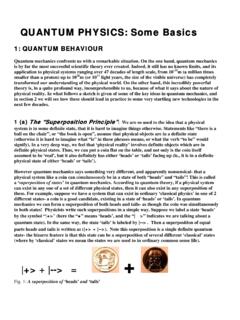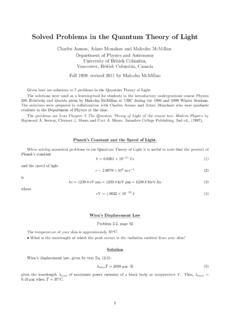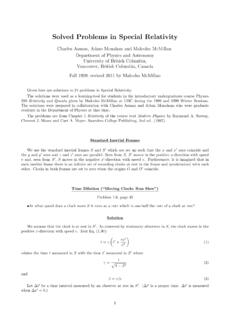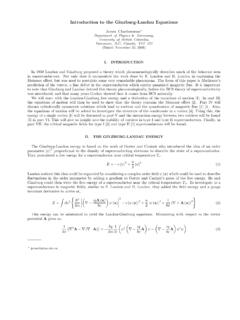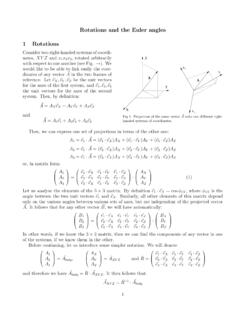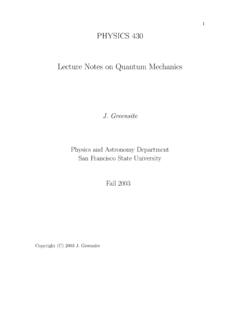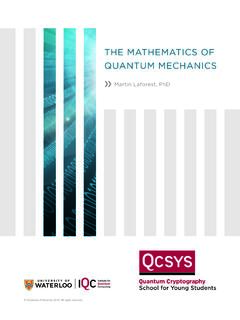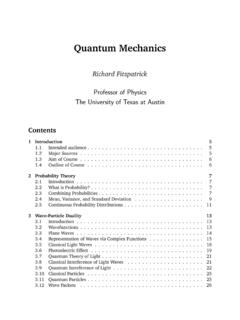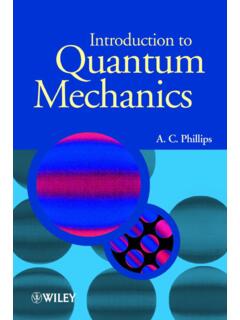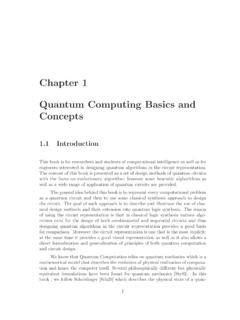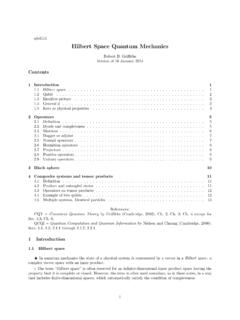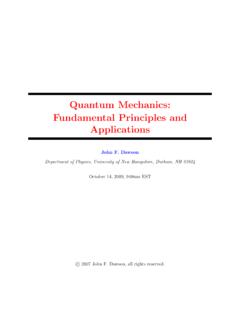Transcription of Solved Problems on Quantum Mechanics in One Dimension
1 Solved Problems on Quantum Mechanics in OneDimensionCharles Asman, Adam Monahan and Malcolm McMillanDepartment of Physics and AstronomyUniversity of British Columbia,Vancouver, British Columbia, CanadaFall 1999; revised 2011 by Malcolm McMillanGiven here are solutions to 15 Problems on Quantum Mechanics in one solutions were used as a learning-tool for students in the introductory undergraduate course Physics200 Relativity and Quantagiven by Malcolm McMillan at UBC during the 1998 and 1999 Winter solutions were prepared in collaboration with Charles Asman and Adam Monaham who were graduatestudents in the Department of Physics at the Problems are from Chapter 5 Quantum Mechanics in One Dimensionof the course textModern Physicsby Raymond A.
2 Serway, Clement J. Moses and Curt A. Moyer, Saunders College Publishing, 2nd ed., (1997).Planck s Constant and the Speed of solving numerical Problems in Quantum Mechanics it is useful to note that the product of Planck sconstanth= 10 34J s(1)and the speed of lightc= 108m s 1(2)ishc= eV nm = keV pm = MeV fm(3)whereeV = 10 19J(4)Also,~c= eV nm = keV pm = MeV fm(5)where~=h/2 .Wave Function for a Free ParticleProblem , page 224A free electron has wave function (x,t) = sin(kx t)(6) Determine the electron s de Broglie wavelength, momentum, kinetic energy and speed whenk= 50 nm 1. Determine the electron s de Broglie wavelength, momentum, total energy, kinetic energy and speed whenk= 50 pm equations relating the speedv, momentump, de Broglie wavelength , wave numberk, kinetic energyE, angular frequency and group velocityvgfor a nonrelativistic particle of massmare:p=mv=h =~k(7)E=12mv2=p22m=~2k22m=~ (8)vg=d dk=v(9)Whenk= 50 nm 1, = 126 pmp= keV/c(10)and, for an electron (m= 511 keV/c2),E= eVv= 10 2c(11)The equations relating the speedv, momentump, de Broglie wavelength , wave numberk, total energyE, kinetic energyK, angular frequency and group velocityvgfor a relativistic particle of massmare.
3 P= mv=h =~k(12)E= mc2=mc2+K= p2c2+m2c4=~ (13)vg=d dk=v=pc2E(14) =1 1 2(15) =v/c(16)Whenk= 50 pm 1, = 126 fmp= MeV/c(17)and, for an electron (m= 511 keV/c2),E= MeVK= MeVv= (18)Potential Energy of a ParticleProblem , page 224In a region of space, a particle with massmand with zero energy has a time-independent wave function (x) =Axe x2/L2(19)whereAandLare constants. Determine the potential energyU(x) of the Eq. ( ) is the time-independent Schr odinger equation for the wavefunction (x) of a particle ofmassmin a potentialU(x): ~22md2 (x)dx2+U(x) (x) =E (x)(20)When a particle with zero energy has wavefunction (x) given by Eq.
4 (19), it follows on substitution intoEq. (20) thatU(x) =2~2mL4(x2 3L22).(21)U(x) is a parabola centred atx= 0 withU(0) = 3~2 Energy From a Transition in an Infinite Square Well PotentialProblem , page 224A proton is confined in an infinite square well of width 10 fm. (The nuclear potential that binds protonsand neutrons in the nucleus of an atom is often approximated by an infinite square well potential.) Calculate the energy and wavelength of the photon emitted when the proton undergoes a transition fromthe first excited state (n= 2) to the ground state (n= 1). In what region of the electromagnetic spectrum does this wavelength belong?
5 SolutionText Eq. ( ) gives the energyEnof a particle of massmin thenth energy state of an infinite squarewell potential with widthL:En=n2h28mL2(22)The energyEand wavelength of a photon emitted as the particle makes a transition from then= 2 stateto then= 1 state areE=E2 E1=3h28mL2(23) =hcE.(24)For a proton (m=938 MeV/c2),E= MeV and = 202 fm. The wavelength is in the gamma ray regionof the Functions for a Particle in an Infinite Square Well PotentialProblem , page 225A particle with massmis in an infinite square well potential with walls atx= L/2 andx=L/2. Write the wave functions for the statesn= 1,n= 2 andn= Eqs. ( ) and ( ) give the normalized wave functions for a particle in an infinite square wellpotentai with walls atx= 0 andx=L.
6 To obtain the wavefunctions n(x) for a particle in an infinite squarepotential with walls atx= L/2 andx=L/2 we replacexin text Eq. ( ) byx+L/2: n(x) = 2 Lsin(n (x+L/2)L)(25)3which satisfies n( L/2) = n(L/2) = 0 as required. Thus, 1(x) = 2 Lcos( xL)(26) 2(x) = 2 Lsin(2 xL)(27) 3(x) = 2 Lcos(3 xL)(28)Position Probability for a Particle in an Infinite Square Well PotentialProblem , page 225A particle is in thenth energy state n(x) of an infinite square well potential with widthL. Determine the probabilityPn(1/a) that the particle is confined to the first 1/aof the width of the well. Comment on then-dependence ofPn(1/a).SolutionThe wave function n(x) for a particle in thenth energy state in an infinite square box with walls atx= 0andx=Lis n(x) = 2 Lsin(n xL).
7 (29)The probabilityPn(1/a) that the electron is betweenx= 0 andx=L/ain the state n(x) isPn(1a)= L/a0| n(x)|2dx=2L L/a0sin2(n xL)dx=1a sin (2n /a)2n (30)Pn(1/a) is the probability that the particle in the state n(x) is confined to the first 1/aof the width ofthe well. The sinusoidaln-dependent term decreases asnincreases and vanishes in the limit of largen:Pn(1a) 1aasn (31)Pn(1/a) = 1/ais the classical result. The above analysis is consistent with the correspondence principle,which may be stated symbolically asquantum physics classical physics asn (32)wherenis a typical Quantum number of the of Quantum Mechanics to a Macroscopic ObjectProblem , page 225A g marble is constrained to roll inside a tube of lengthL= cm.
8 The tube is capped at both ends. Modelling this as a one-dimensional infinite square well, determine the value of the Quantum numbernifthe marble is initially given an energy of mJ. Calculate the exitation energy required to promote the marble to the next available energy allowed energy valuesEnfor a particle of massmin a one-dimensional infinite square well potentialof widthLare given by Eq. (22) from whichn= 1028(33)whenEn= excitation energyErequired to promote the marble to the next available energy state isE=En+1 En=(2n+ 1)h28mL2= 10 32J.(34)This example illustrates the large Quantum numbers and small energy differences associated with the be-havior of macroscopic Levels for a Particle in a Finite Square Well PotentialProblem , page 225A particle with energyEis bound in a finite square well potential with heightUand width 2 Lsituated at L x + potential is symmetric about the midpoint of the well.
9 The stationary state wave functions are eithersymmetric or antisymmetric about this point. Show that forE < U, the conditions for smooth joining of the interior and exterior wave functions leadsto the following equation for the allowed energies of the symmetric wave functions:ktankL= (35)where = 2m(U E)~2.(36)andk= 2mE~2(37)kis the wave number of oscillation in the interior of the well. Show that Eq. (35) can be rewritten askseckL= 2mU~(38) Apply this result to an electron trapped at a defect site in a crystal, modeling the defect as a finite squarewell potential with height 5 eV and width 200 wavefunction (x) for a particle with energyEin a potentialU(x) satisfies the time-independentSchr odinger equation Eq.
10 (20).Inside the well ( L x L), the particle is free. The wavefunction symmetric aboutx= 0 is (x) =Acoskxwherek= 2mE~2.(39)Outside the well ( < x < LandL < x < ), the potential has constant valueU > E. Thewavefunction symmetric aboutx= 0 is (x) =Be |x|where = 2m(U E)~2.(40)5 (x) and its derivative are continuous atx=L:AcoskL=Be L(41)AksinkL=B e L(42)from whichktankL= (43)or, alternatively, sec = a(44)where =kL(45)anda= 2mUL2~2(46)Eq. (44) are equations for the allowed values ofk. The equation with the positive sign yields values of inthe first quadrant. The equation with the negative sign yields values of in the third Eq.
